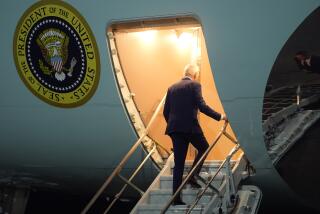Electoral deadlock between Romney, Obama not so far-fetched this year
With President Obama and Mitt Romney tied in the latest national polls, this may not come as a huge surprise: An electoral college deadlock between opponents — something that has never happened under our centuries-old process of choosing a president — is more than a remote, theoretical possibility.
Depending on how a handful of swing states fall on the battleground map, American voters may not choose the next president in November. Instead, that decision could be thrown into the House of Representatives, where, in all likelihood, Romney would become the next president.
All it would take for that to happen: President Obama carries most of the states he won in 2008, including Colorado and Virginia, swing states now rated as tossups. Mitt Romney holds the states that John McCain won last time, recaptures Republican Indiana and North Carolina and carries five swing states that are current tossups, Florida, Ohio, New Hampshire, Iowa and Nevada.
In that case, Obama and Romney each winds up with 269 electoral votes — one short of the 270 needed to win.
There are several wild cards to consider. Unlike the winner-take-all rule in most states, Nebraska and Maine award electoral votes by congressional district. That seldom results in a split decision, but four years ago it did. President Obama picked up one electoral vote in Nebraska by narrowly winning an Omaha area district (by just 3,370 votes out of more than 275,000 cast), while McCain carried the state. Redistricting last year made that district more Republican, however, diminishing Obama’s chances of winning it again.
Another possibility would be for an elector to go rogue. From time to time, faithless electors have refused to follow the election results, taking advantage of their legal right to cast a vote for someone other than the candidate they were originally pledged to support. In the 2000 election, a District of Columbia elector abstained, in a symbolic protest over the District’s lack of voting representation in Congress, costing Al Gore one electoral vote in the process (he wound up four short, anyway, despite having beaten George W. Bush in the popular vote).
In the event of an electoral-vote deadlock, the Constitution orders the House of Representatives to hold what is known as a contingent election. Each state’s delegation casts one vote. Thus, each of the seven states with a single House member, such as Alaska, South Dakota and Wyoming, has power to select the next president that is equal to California’s 53-member delegation.
Republicans currently control roughly twice as many state delegations as Democrats in the House, and are likely to maintain an advantage in the next Congress, all but assuring Romney of victory in January if the November election is inconclusive.
The only previous case of an electoral-vote tie came in 1800, under an earlier system. Thomas Jefferson and Aaron Burr, running for president and vice president on the same ticket, got an identical number of electoral votes for president, due to a flaw in the Constitution (quickly corrected by the 12th Amendment, which was ratified in 1804). There was also a contingent election after the 1824 election, when none of the three leading candidates won a majority of the electoral vote. In that case, the House chose John Quincy Adams as the president, even though Andrew Jackson won the most popular votes.
Follow Politics Now on Twitter
Twitter: @paulwestdc
More to Read
Get the L.A. Times Politics newsletter
Deeply reported insights into legislation, politics and policy from Sacramento, Washington and beyond. In your inbox three times per week.
You may occasionally receive promotional content from the Los Angeles Times.










